Catch a glimpse of the Alps in Wales, see a mysterious double sunset, and climb the Yorkshire summit said to be more impressive than K2. Spring’s here, and it’s time to hit the hills.
1. Y Garn via Cwm Idwal, Snowdonia
A glimpse of the Alps amid the hanging gardens of Wales
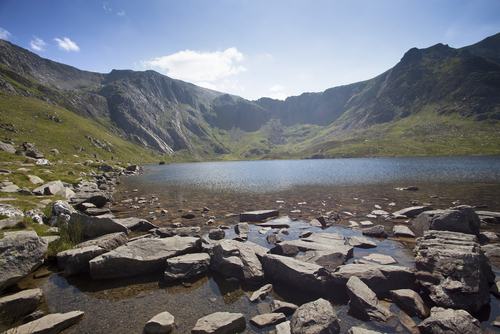 Cwm Idwal (phildaint / Shutterstock
Cwm Idwal (phildaint / Shutterstock
Spring is famously the best time for wildflowers in the Alps, when the mountain meadows bloom into galaxies of riotous colour. You don’t have to travel to Switzerland to get a glimpse of this splendour, though. Britain’s mountain areas provide habitats that are right on the edge of the range where these hardy, highly-specialised, but fragile flowers can grow.
Sheep are the nemesis of arctic-alpine vegetation, but it can still thrive in chinks and pockets in crags and cliffs where their jaws can’t reach. The glacial amphitheatre of Cwm Idwal in Snowdonia, sometimes dubbed ‘nature’s hanging garden’, is one such place. Starry saxifrages, the rare Snowdon lily and carnivorous butterworts are just some of the rare flora to be found here, among some equally impressive glacial geology. A walk over Y Garn leads to a beautiful summit view and rare dwarf willow. Charles Darwin often came to this area to study its natural history and collect plants – but it goes without saying that today you should leave them put.
ROUTE: Y Garn and Cwm Idwal (Trekking Britain)
2 and 3. Parkhouse Hill and Chrome Hill, Peak District
Miniature mountains and a mysterious double sunset
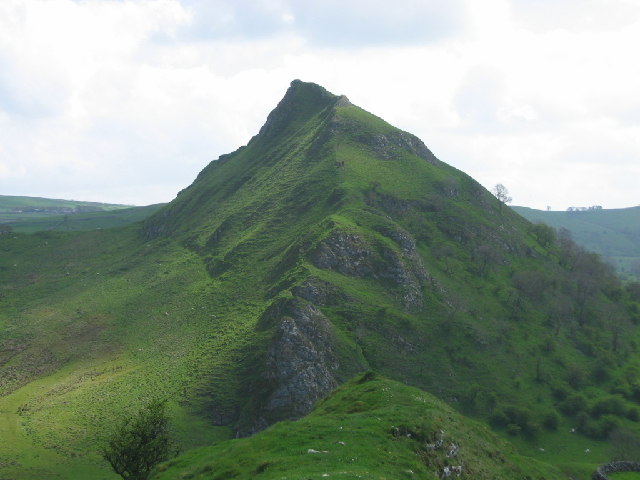 Parkhouse Hill (Paul Ashwin, geograph.co.uk)
Parkhouse Hill (Paul Ashwin, geograph.co.uk)
If Parkhouse hill and neighbouring Chrome Hill were people, they’d have a bad case of Napeoleon syndrome. At just 442 and 379 metres respectively, both are mere pimples in the grand scheme of things, but you wouldn’t want to say it to their face. The ultimate miniature mountains, it’s extraordinary (and slightly morbid) to think they are, in a way, big piles of bone; both once existed as teeming coral reefs under a tropical sea in which the skeletal remains of coral and fish hardened over millennia into rock. Few places in Britain illustrate the wonder of limestone formation more vividly.
Spring is a good time to visit, as the limestone soil hosts a rich range of vegetation including purple wild thyme, orange-gold hawkweeds, nodding thistles and sun-coloured rockroses. At this time of year Parkhouse Hill is also the site of the ‘mysterious’ double sunset phenomena; from nearby Glutton Grange, the sun appears to set just to the south of the hill’s summit before fully reappearing from its steep northern slop and setting for a second time at the foot of the hill.
ROUTE: Chrome and Parkhouse Hill from Earl Stearndale (Walking Britain)
4. Blencathra, Lake District
Spring scrambling on the perfect hill walker’s hill
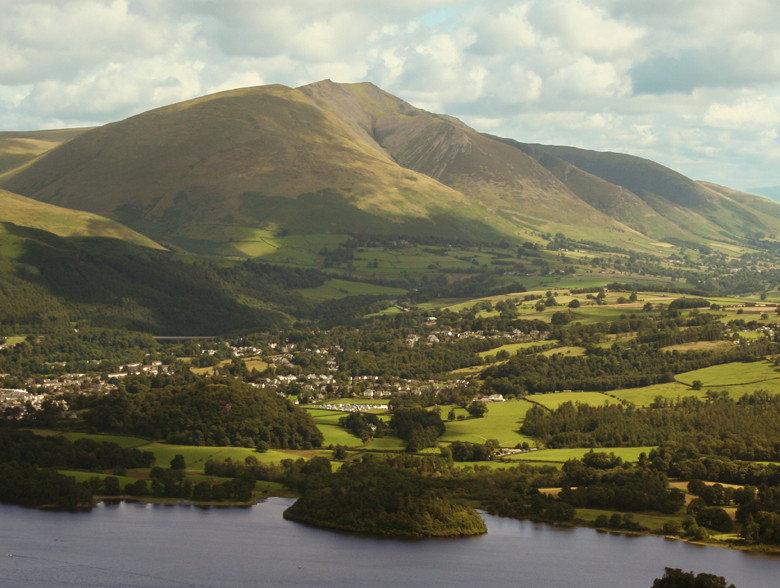 Blencathra from Catbells. Many thanks to Graham Kendall and Borrowdale House for the use of the picture.
Blencathra from Catbells. Many thanks to Graham Kendall and Borrowdale House for the use of the picture.
“I’m always asked what my favourite mountain is and am expected to say Everest, but I always say Blencathra.” So said Doug Scott, the first Briton to climb Everest along with Dougal Haston in 1975, and he’s not alone in his opinion. Writer Ronald Turnbull described Blencathra as the perfect hillwalker’s hill; just the right amount of craggy sharpness to keep things interesting, but not too much to make it scary or uninviting.
Seen from the Vale of Keswick, the vast arms of Blencathra’s southern ridges can evoke the atmosphere of the Alps, but the real monster lies on the eastern side of the mountain in the form of Sharp Edge, a dragon-backed ridge that is one of the most committing and exposed Grade 1 scrambles in Lakeland. But if you don’t fancy risking your neck, there’s no need to worry. Blencathra’s rippling ridges are an extensive menu, allowing you to pick and choose from spicy scrambles to plucky plods. On a sunny spring day, soaking up the view over Derwentwater and the northern fells, all shapes and sizes of walkers will feel equally at home on Blencathra’s summit.
ROUTE: Blencathra via Sharp Edge (Trekking Britain)
5. Kisdon, Yorkshire Dales
Wildflower wonder in the Yorkshire Dales’ tranquil corner
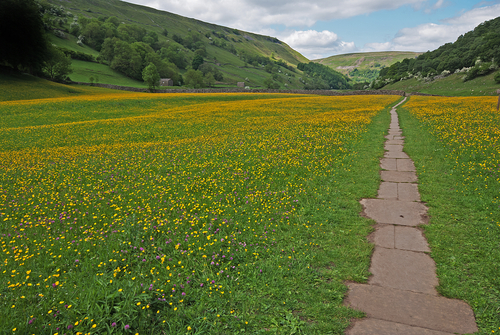 Spring colour in Swaledale (Andrew Fletcher / Shutterstock)
Spring colour in Swaledale (Andrew Fletcher / Shutterstock)
This hill is actually a bit of a red herring on this list, included not so much for the hill itself as what can be found below it. The fields around the villages of Keld, Thwaite and Muker in Swaledale are the site of one of the most spectacular spring displays in England, when the usually mute pastures burst forth into seas of vibrant yellow and purple colour. Just pronouncing the names of some of the flower species present is a delight in itself; buttercups, clover, cat’s ear, wood crane’s bill, lady’s mantle, pignut and the evocatively-named melancholy thistle, to name a few.
While it may seem an impressive natural spectacle, the profusion and diversity of flowers is actually the result of careful co-management by the National Park Authority and local farmers. The climb of Kisdon via the corpse road – once used for transporting, you guessed it, dead bodies – is an easy one (when not lugging a coffin, anyway), and a lot more pleasant than its history suggests.
ROUTE: Kisdon Fell circular from Thwaite (Where2Walk)
6. Bidean nam Bian, Glen Coe
Climb the lord of Glen Coe before the midges eat you alive
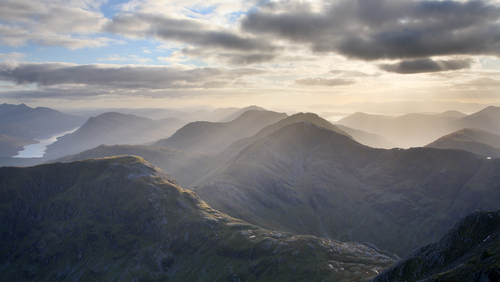 The view from Bidean nam Bian (N Mrtgh / Shutterstock)
The view from Bidean nam Bian (N Mrtgh / Shutterstock)
Bidean nam Bian is a brute among brutes. Its summit is not even visible to mere glen-dwellers; to gain it you must first walk past the towering ridges of the Three Sisters which stand guard over the southern side of Glen Coe like huge, bulging sentinels. As you climb, the knife-edge ridge of the Aonach Eagach looks down from the other side of the glen with Mordor-like menace. It’s safe to say Glen Coe can be a foreboding place, especially with an awareness of its famous history of massacre and betrayal.
But this is also some of the finest, most rewarding hill walking country in the British Isles, and in common with most of the Highlands, the best time to visit is often spring. Though nothing is guaranteed when it comes to the mercurial Highland weather, April and May frequently see stable periods, and as an added bonus the midges haven’t emerged from hibernation yet, meaning you can enjoy being in nature without getting eaten alive by it.
ROUTE: Bidean nam Bian (Walkhighlands)
A ward of warning - like many Scottish mountains, Bidean often holds snow well into spring, so make sure you check weather and conditions beforehand. If snow and ice are lying don't go unless you're equipped for winter conditions.
7. Roseberry Topping, North York Moors
The tiny Yorkshire hill that looks like the Matterhorn and beats K2
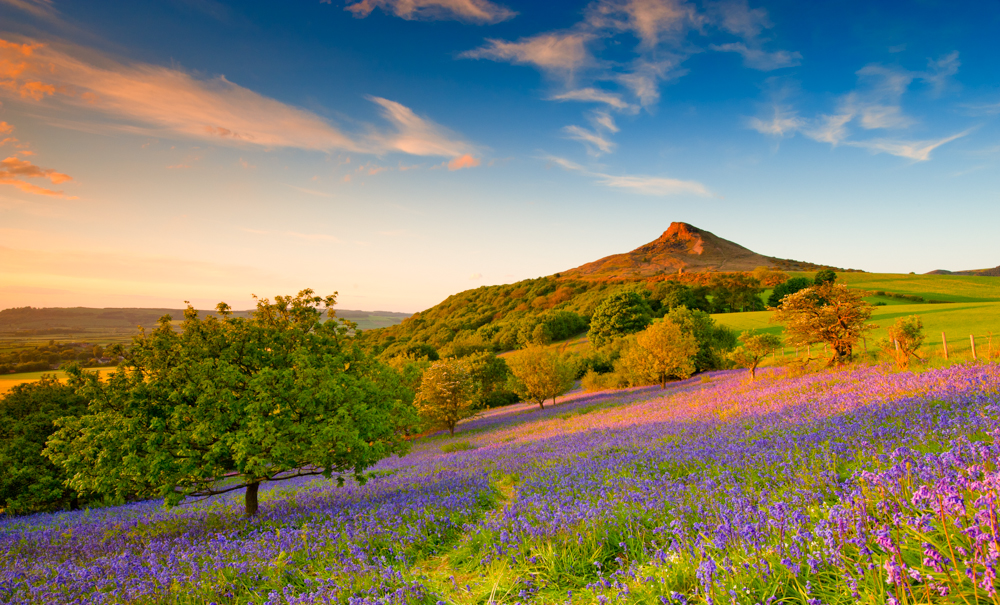 Roseberry Topping (Colin Carter)
Roseberry Topping (Colin Carter)
At just 320 metres Roseberry Topping is the shorty of this bunch, but what it lacks in height it makes up for with character. Alan Hinkes, the first Briton to climb all 14 of the world’s 8,000 metre peaks, thinks it’s more impressive than K2. Roseberry Topping is used to such grandiose comparisons; the shape of its half-cone summit has earned it the tongue-in-cheek nickname of the ‘Yorkshire Matterhorn’ thanks to its resemblance to the iconic Swiss – Italian mountain.
An outlier of the North York Moors, Roseberry Topping’s unusual geology means it stands tall above the terrain surrounding it, but the striking summit is actually the product of ironstone mining causing a chunk of the peak to fall away in 1912. In spring, the bright-purple bluebell carpets of nearby Newton Wood rival any Alpine view in the spectacle stakes.
ROUTE: Roseberry Topping and Newton Wood (National Trust)
.jpg)
We want to say a big thanks to every BMC member who continues to support us through the Coronavirus crisis.
From weekly Facebook Lives and GB Climbing home training videos, to our access team working to re-open the crags and fight for your mountain access, we couldn’t do it without you.
Did you know that we've launched a U27 membership offer for just £1.50 / month? And with full membership from £2.50 / month, it's never been easier to join and support our work:
https://www.thebmc.co.uk/join-the-bmc-for-1-month-U27-membership
« Back